Now we will walk you through the installation space.
The installation was housed within the Blanchard Student Art Gallery. The front wall is mostly glass. If you were to walk up to the glass, this is what you would see. On the left, we collaged over the glass with newspapers. The newspapers had some cut-outs scattered throughout, to evoke the imagery of frames. Specific headlines and stories are highlighted through the cutouts on the newspaper. The cut out portions encourage viewers to look through them to attempt to see what is present on the other side of the glass. On the right side of the door, there are multiple pieces of colored construction paper, with a snippet (maybe a headline, maybe an image, maybe an infographic) from the newspapers on the left stuck to them. The singular snippets are emphasized further by the fact that they are the only thing that take up space on the construction paper. The viewer is automatically drawn only to that single snippet, mimicking the reverse effect of a newspaper. The bottom of the glass had a reflective wrapping paper-like material.
Both sides of the glass wall are intended to make the viewer engage with themes of framing and how we contextualize and access the knowledge we know. Newspapers and other vessels of news impact the ways through which we access and take in realities that exist outside of the spaces we are familiar with. For most people, the news is a space where they learn about the rest of the world. The narrative of the news impacts the associations we make with those spaces or identities. By cutting out the newspapers and the headlines, we hoped to physically subvert hegemonic news and knowledge productions. Engaging with the first materials on the glass also acts as an exercise to see where your eye is naturally drawn and what you choose to read (and not read).
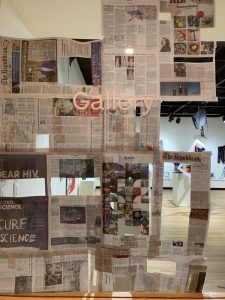
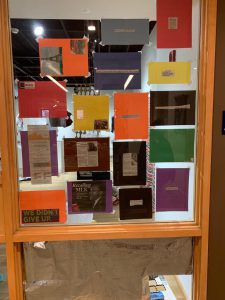
The doors themselves had a cloth-like material (table covers) draped over them in shades of blue. This is meant to evoke a sensory image of water and the movements embedded in it.
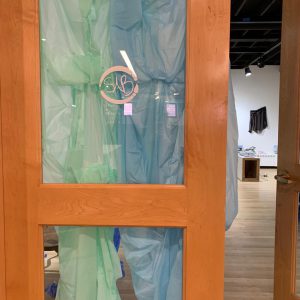
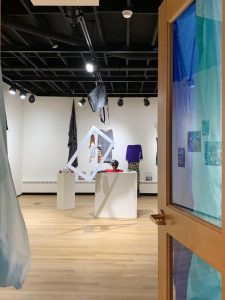
Now, to go around the room.
There was a dotted line of painter’s tape placed on the floor to suggest a path which begins with the left side. If you were to follow the path and turn left, you would see the original project we made in class.
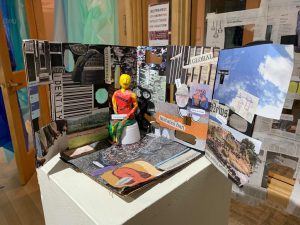
The project is a miniature model of a room with frames cut into the walls that manipulate what is and is not visible to the eye. The idea is that a viewer would look through the frames and only be able to see a section of the inner collage and the figure in the center. Such a view can be seen in the image below. Inside, the collage had questions such as “Who are you?” “Who am I?” The frames combined with the collaging are designed to inspire introspection, analysis, and questions surrounding themes of migration and belonging. They are also intended to make the viewer question their relationship with how they reconcile the world through the social structures they have been surrounded by. The frames work as a way to remind us that those social structures embedded in us cause us to look at the world through the specific shapes those frames create.
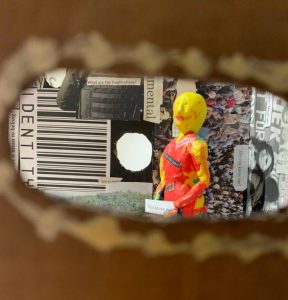
After viewing the miniature model, the viewer would come into contact with our artist’s statement, which is similar to the introduction on our home page. On the wall toward the right side the artist’s statement are the collages we created during our BOOM workshop.
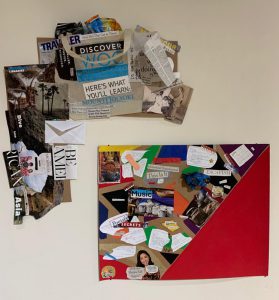 The BOOM workshop was meant to help each person reflect on their own relationship to migration and home. Using paint, painter’s tape, newspaper and magazine clippings, and items brought from home, individuals were encouraged to artistically consider what these themes meant to them. Below is an image of four collages created during our workshop. The artists behind these collages kindly agreed to have their work displayed.
The BOOM workshop was meant to help each person reflect on their own relationship to migration and home. Using paint, painter’s tape, newspaper and magazine clippings, and items brought from home, individuals were encouraged to artistically consider what these themes meant to them. Below is an image of four collages created during our workshop. The artists behind these collages kindly agreed to have their work displayed.
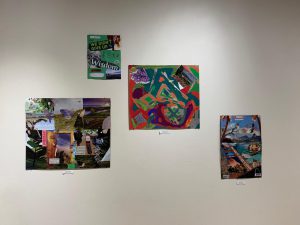
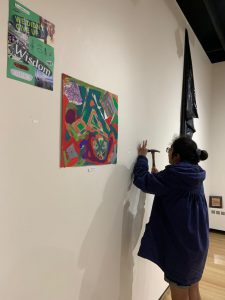
Directly in front of the collages was a broken picture frame. The frame contained scattered puzzle pieces from an elephant puzzle and a directive to solve it. This exercise was meant to encourage the viewer to pay closer attention to each item placed in the installation space and to “look for the right pieces”.

By the end of the installation, the puzzle was mostly solved. The only pieces missing were some of the ones scattered throughout the room, although most of the scattered pieces had been found.
In the very center of the room hangs a diorama. The diorama is constantly turning slowly and the viewer can look up the diorama itself; which is an empty black bag turned inside out with a frame, shoes, and cloth hanging out o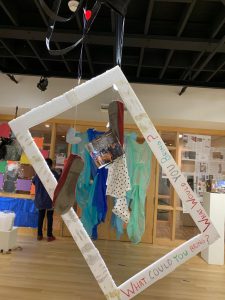 f the bag. The diorama is intended to represent the physicality of migration and movement. It is meant to probe viewers to think about the objects they are attached to and how migration, materialism, and capitalism have a complex relationship. The frame falling out of the diorama bag asks: What would you bring? What could you bring?
f the bag. The diorama is intended to represent the physicality of migration and movement. It is meant to probe viewers to think about the objects they are attached to and how migration, materialism, and capitalism have a complex relationship. The frame falling out of the diorama bag asks: What would you bring? What could you bring?
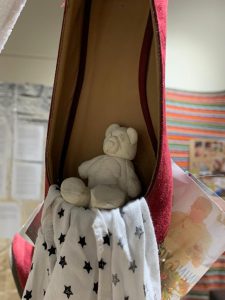 Inside one of the shoes attached to the diorama is a small clay bear. This bear is intended imply the relationship between children and movements and migration and how they may be impacted by such changes.
Inside one of the shoes attached to the diorama is a small clay bear. This bear is intended imply the relationship between children and movements and migration and how they may be impacted by such changes.
The diorama and all of its elements were curated to evoke specific thematic connections and imagery; and to raise a specific discussion about the people that are impacted by (chosen and unchosen) migrations and how a lot of the times, we see their journeys only through the items they were able to bring with them and the items they were forced to leave behind. Objects, in turn, become vessels of memory and identity as they are imbued with the histories of the people they are affiliated with and the geographies they have moved across. The constant turning of the diorama also encourages the viewer to circle around the diorama and look up the dark bag.
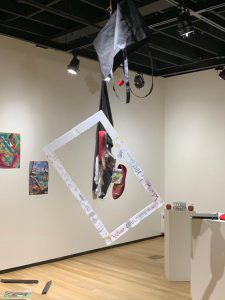
After circling the center of the room, the viewer can explore the back most section of the gallery space. The left corner of the room first brings the viewer to a small fence-like figure with two wax apples on either of its side. The white fence is made of metal and has sharp bottom edges; the fence is lined with metal flowers that seem beautiful at first glance but are also sharp.
The top layer of the fence facing the viewer asks questions regarding whether the fence is protecting by keeping safe (inside) or keeping someone out? This piece was intended to be a commentary on themes of safety and what safety looks like for different people. Narratives of safety are also further complicated through their interaction with national security. The fence also acts as a criticism of the racialization of “safety” and narratives of national protection that are discriminatory.
Behind the small white fence figure is the left-most corner of the room. There,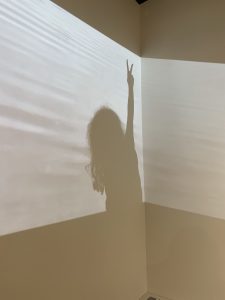 one can see a projection of a film of moving water that is framed by hanging black trash can bags. The projection is coming from the right corner of the room. This allows viewers to be able to stand in front of the projection and produce their silhouettes onto the projection film. The film is also actively projected onto a corner of the room to break the fixedness and rigidity of the room and to create a sense of movement and flow. Viewers can partake in this sense of movement by looking at their silhouette.
one can see a projection of a film of moving water that is framed by hanging black trash can bags. The projection is coming from the right corner of the room. This allows viewers to be able to stand in front of the projection and produce their silhouettes onto the projection film. The film is also actively projected onto a corner of the room to break the fixedness and rigidity of the room and to create a sense of movement and flow. Viewers can partake in this sense of movement by looking at their silhouette.
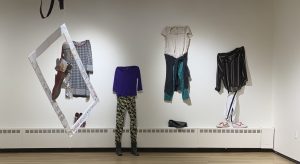 Part of the projection is projected onto the back-most wall of the gallery space. To the very right of the projection, on the same back wall, are four sets of clothing. Each set of clothes also has shoes sitting directly beneath the clothing. All the clothing used in the installation was recycled and found through free-clothes bins in Mount Holyoke dorms. In the final form of the exhibit, there are carved out books between each of the shoes.These books are part of a world tourism exploration set and were published in a time when it was not uncommon to use the term “The Orient”. We carved the books into frames.
Part of the projection is projected onto the back-most wall of the gallery space. To the very right of the projection, on the same back wall, are four sets of clothing. Each set of clothes also has shoes sitting directly beneath the clothing. All the clothing used in the installation was recycled and found through free-clothes bins in Mount Holyoke dorms. In the final form of the exhibit, there are carved out books between each of the shoes.These books are part of a world tourism exploration set and were published in a time when it was not uncommon to use the term “The Orient”. We carved the books into frames.
In front of the clothes, a mirror is held to the wall. It is only visible from that corner. The use of the mirror here, and the other mirror placed on a pedestal, is meant to highlight themes of visibility/invisibility. Who can see you, and when, and why? When and where and how can you see yourself?
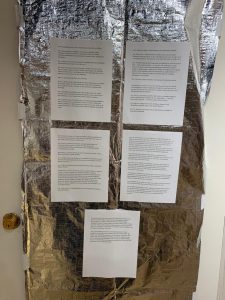 We are now on the right side of the gallery space. Here, there lies a door. It is a part of the space, guarding merely the supplies of the art gallery. On it, however, there is a shiny reflective surface similar to that on the bottom of the glass walls. On the reflective surface are print-outs with a timeline of major shifts in US migration policies. The reflective surface (a re-purposed table cloth) almost shows the viewer, but the viewer is just a little distorted. The policies are revealing, and highlight a history of exclusionary policies created and upheld by the US government. A history of systemic discrimination is revealed within the documents. It lies, tellingly, besides a quilt which has a collage about home on it. What does it mean to juxtapose these exclusionary policies with concepts of home? What prerequisites to belonging are revealed in the way these magazine clippings depict home? These excerpts are from US based magazines and newspapers.
We are now on the right side of the gallery space. Here, there lies a door. It is a part of the space, guarding merely the supplies of the art gallery. On it, however, there is a shiny reflective surface similar to that on the bottom of the glass walls. On the reflective surface are print-outs with a timeline of major shifts in US migration policies. The reflective surface (a re-purposed table cloth) almost shows the viewer, but the viewer is just a little distorted. The policies are revealing, and highlight a history of exclusionary policies created and upheld by the US government. A history of systemic discrimination is revealed within the documents. It lies, tellingly, besides a quilt which has a collage about home on it. What does it mean to juxtapose these exclusionary policies with concepts of home? What prerequisites to belonging are revealed in the way these magazine clippings depict home? These excerpts are from US based magazines and newspapers.
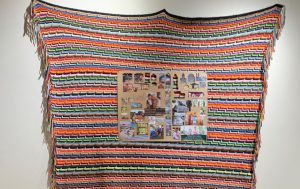
In front of the quilt lies a microwave. The microwave is on top of netting which has trash and leaves attached to it.
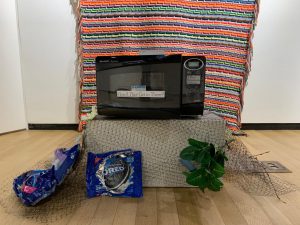
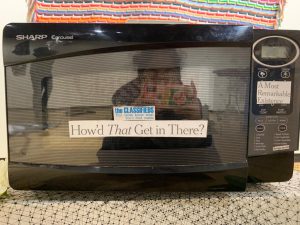
When you get closer, you realize the microwave is asking questions. On top of it lies a VCR tape with a movie about Yellowstone national park which has been collaged to evoke ideas of climate change, and apocalypse.
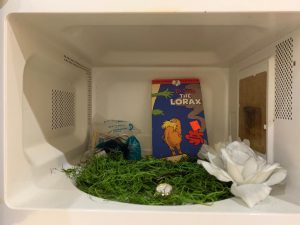
If you were to open the microwave, you would find many objects hidden within the frame of the door. A grey flower, a watch which only occasionally works, a small stuffed toy of a bear hidden within a plastic wrapping, another video about the impending possibilities of climate change.
The rest of this corner seems to continue the question of environment, and climate change. It includes an altered plastic water dispenser, two collages, hanging pots, and a hanging wood cutting with plastic poking through it. The hanging wood cutting proclaims “the plastic is stronger than the wood.” Whether this is alluding to environmental policies, or the fact that the plastic within the frame is literally capable of breaking the wood frame, is up to interpretation.
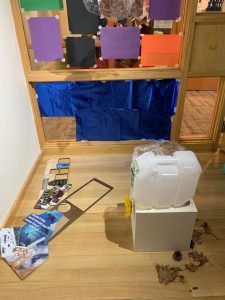
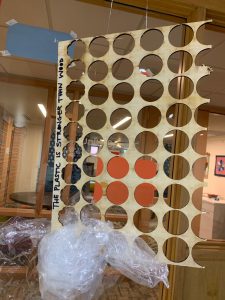
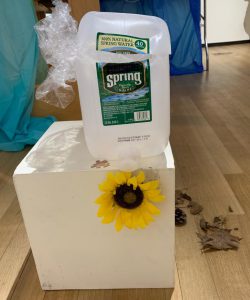
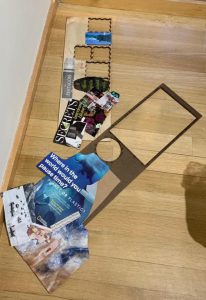
With this, we return to the front of our installation.
Below is a slideshow with the photos (more than are displayed on this page).
[slideshow_deploy id=’174′]
